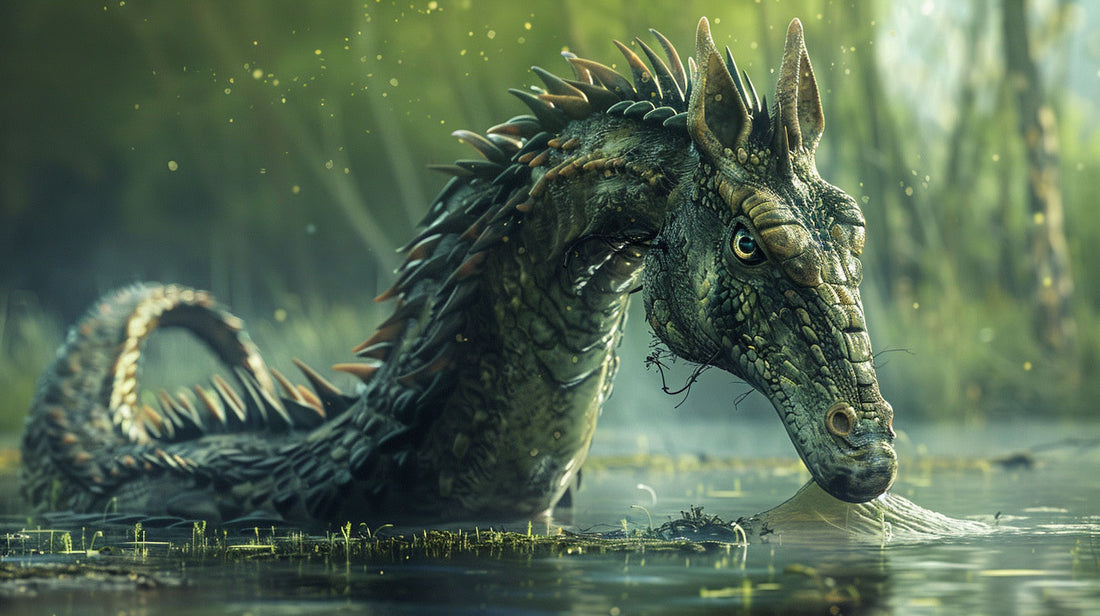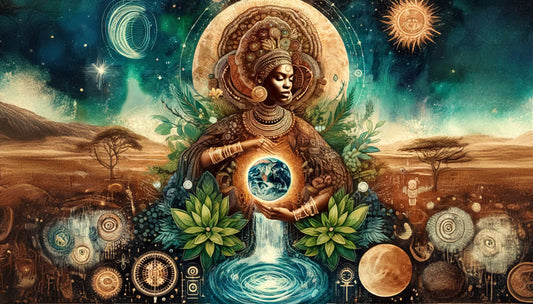Ninki Nanka: Serpent Creature of the Mangroves of Africa
Gil Santos
The legend of Ninki Nanka, a mysterious creature said to inhabit the mangroves of West Africa, has fascinated people for generations. This elusive being is often described as having a long neck, large size, and features that blend reptilian and equine traits.
Despite numerous accounts from locals who claim to have encountered the beast or felt its presence, concrete evidence remains elusive, leaving skeptics and believers in a continuous debate about its existence.
The allure of Ninki Nanka goes beyond mere curiosity; it taps into our innate desire to explore the unknown and understand the mysteries that lie at the edges of human knowledge and folklore.
Key Takeaways
- The Ninki Nanka is a fascinating cryptid from West African folklore, embodying a rich tapestry of cultural stories and beliefs.
- Its evolution and history highlight how myths adapt over time, reflecting changes in society and the natural environment.
- Understanding the physical traits and alleged powers of the Ninki Nanka can inspire creativity and curiosity about the natural world and its mysteries.
- Historical sightings and encounters with the Ninki Nanka serve as a reminder of the human penchant for storytelling and the need to connect with the unknown.
- Comparing the Ninki Nanka to global cryptids reveals universal themes in how different cultures interpret unexplained phenomena.
- The creature's influence on modern culture, including literature, movies, and video games, underscores the enduring appeal of myths and legends.
- Challenges in fully understanding myths like the Ninki Nanka underscore the importance of preserving oral histories and cultural narratives for future generations.
Ninki Nanka Overview
Origin Story
The Ninki Nanka comes from deep within West African folklore. It is a tale passed down through generations. People in villages would gather to share stories of this mysterious creature.
Legends say the Ninka Nanka lives in swamps and rivers. Parents often tell their children about it, warning them to stay away from these areas. The story serves as a lesson and a way to keep kids safe.
Creature Description
The Ninka Nanka is no ordinary animal. Described as dragon-like, it sparks fear and awe. Its appearance varies across tales but always remains imposing.
Some say it has a long neck and large scales that shimmer in sunlight. Others talk about its massive size, capable of towering over trees. Despite differences, all agree on its extraordinary presence.
Deadly Powers
Villagers whisper about the Ninka Nanka's deadly gaze or breath. Meeting its eyes or being too close can spell doom for the unlucky ones.
- Gaze: Just looking into its eyes can cause illness or even death.
- Breath: Its breath is said to bring misfortune or sickness to those who inhale it.
These powers make the ninka nanka not just an animal but a force of nature in local lore.
Evolution and History of the Myth
Oral Traditions
The Ninki Nanka folklore has its roots deep in the oral traditions of the Mandinka people. For generations, this story was passed down orally from elders to youngsters.
Just like other mythical creatures found in African Mythology, these stories about the ninki nanka were used to teach important lessons or to help people understand things happening in nature.
In these early versions, details of the Ninki Nanka varied. Yet, its essence as a mysterious creature remained constant. The stories were not just entertainment but also carried moral and cultural significance.
Cultural Variations
Across West Africa, variations of the Ninki Nanka myth exist. Each culture adds its unique twist to the tale, reflecting local beliefs and environments.
For instance, in some regions, it's seen as a benevolent guardian. In others, it is feared as an omen of disaster. These differences highlight how flexible oral traditions can be. They adapt to fit new contexts while keeping core elements intact.
Physical Traits and Description
Serpentine Body
The Ninki Nanka is often depicted with a long, serpentine body. This creature's form resembles that of a snake but on a much larger scale. Its body winds and curves, allowing it to move gracefully through water or perhaps even across land.
This elongated shape contributes to its mysterious aura. Imagine seeing something so vast moving silently in the water. It would be both fascinating and terrifying.
Horse-like Head
One of the most distinctive features of the Ninki Nanka is its horse-like head. Unlike typical serpents with narrow, pointed faces, this creature has a broader head shape reminiscent of a horse's.
Its eyes are said to be large and expressive, adding an almost gentle quality to its otherwise intimidating appearance. The contrast between its serpent body and equine face makes it uniquely captivating.
Elongated Neck
Another key trait is its elongated neck. This feature allows the Ninki Nanka's head to rise high above water or ground level when needed.
The neck’s length provides versatility in movement and perception, enabling it to survey wide areas without fully revealing itself. Such adaptability adds layers to its enigmatic nature.
Scales
The skin of the Ninki Nanka is covered in scales. These aren't just any scales; they're often described as reflective or shining like knives under sunlight.
These scales serve as armor against predators or threats while also playing an essential role in their mystique.
Size Variations
Accounts regarding the size of the Ninki Nanka vary significantly:
- Some stories tell of creatures so immense they can wrap around entire villages.
- Others suggest sizes more comparable to large snakes found today.
Regardless of these differences, all accounts agree on one thing: this creature cannot be ignored due to its sheer presence alone.
Powers and Abilities
Supernatural Forces
The Ninki Nanka is shrouded in mystery, with many believing it holds terrifying supernatural powers. It's said that just looking at this creature can bring about severe illness or even death. This belief instills fear in the hearts of those who hear tales of its existence.
Communities living near its supposed habitats treat the Ninki Nanka with a mix of respect and fear. They share stories warning against seeking it out.
Some say that the mere presence of the creature can cause unexplained sicknesses to sweep through villages. These accounts add to the legendary status of the Ninki Nanka, making it an entity not to be trifled with.
Shape-shifting Ability
Another fascinating aspect attributed to the Ninki Nanka, like many legends in the African Mythology, is its ability to shape-shift or become invisible at will. Imagine walking through a dense forest, feeling watched, but seeing nothing; that could be the Ninki Nanka keeping itself hidden.
There are stories where it transforms into various forms, sometimes even mimicking human appearances to blend into communities unnoticed. This capacity for disguise makes pinpointing its true form difficult for researchers and storytellers alike.
- The ability to vanish from sight adds another layer of complexity in proving its existence.
- Tales mention instances where individuals claim having encountered the beast without realizing until later reflections.
Historical Sightings and Encounters
Ancient Reports
Reports of the ninki nanka have been whispered for centuries. The tales come mainly from West Africa. These stories were passed down through generations.
Many believe these accounts are more than just myths. They argue that such consistent storytelling across different cultures cannot be dismissed easily. Yet, the lack of physical evidence makes some people doubt.
Colonial Increase
During the colonial period, sightings reportedly spiked. This was a time when many foreigner invaders arrived in West Africa. Some think that these outsiders misinterpreted local legends.
Others suggest that the increased encounters could be due to more people venturing into the creature's supposed habitats. Journals from those years sometimes mention strange sightings by explorers and colonists alike.
Skepticism vs Intrigue
The absence of concrete proof has fueled skepticism over the years.
- Scientists demand physical evidence.
- Believers rely on eyewitness accounts and ancient lore.
This divide creates an ongoing debate about the ninki nanka's existence.
On one hand, skeptics point out how easy it is to fabricate tales or mistake other animals for this mythical creature. On the other hand, enthusiasts find it hard to dismiss hundreds of years of consistent reports.
Theories Surrounding the Creature
Protective Spirit
Many indigenous cultures view the ninki nanka as a protective spirit. They believe it guards their communities and natural resources. This perception adds a layer of respect and reverence for the creature among these groups.
The idea of protection comes from ancient traditions. Stories passed down through generations emphasize its role in safeguarding people from harm. These tales often highlight encounters where the ninki nanka intervened during times of danger, providing a safe passage or warning against threats.
Skeptical Views
Skeptics argue that sightings are either misidentifications or exaggerated folklore. They suggest that what people see could be known animals, such as giraffes, mistaken for something more mysterious due to distance or poor visibility.
Research into these skeptical views reveals common patterns in human psychology. People tend to remember events more vividly if they involve elements of fear or surprise. This can lead to embellishing details over time, making ordinary animals seem like legendary creatures.
Dinosaur Connection
Some theories propose connections between dinosaur fossils and local myths about the ninki nanka. Discoveries on the ground might have inspired stories about giant reptiles long before modern science explained them.
This connection is fascinating because it suggests how various characters in folklore could stem from real-world observations misunderstood by ancient peoples. It also shows how death and mystery often contribute to myth-making processes across different cultures.
Asian Dragons Comparison
The ninki nanka and Asian dragons share striking similarities. Both are long, serpentine creatures with mystical powers. In many stories, they can control water or the weather. This makes them revered in cultures that value harmony with nature.
Asian dragons are often seen as protectors or symbols of good luck. They appear in art, festivals, and stories across Asia. The ninki nanka is also believed to have protective qualities by some West African communities.
However, their appearances differ slightly. Asian dragons typically have legs and can fly without wings. The ninki nanka is mostly described as a water-dwelling creature without limbs that resemble those of a dragon.
Conclusion
In conclusion, the Ninki Nanka, with its deep roots in West African folklore, continues to be a subject of fascination and mystery. Despite the lack of concrete evidence to substantiate its existence, the creature remains an integral part of the cultural heritage and storytelling traditions of the region. Its impact extends beyond mere tales, influencing modern media, tourism, and even conservation efforts. The allure of the unknown and the human penchant for exploration of the unexplained ensure that the legend of the Ninki Nanka persists, captivating the imagination of both locals and the wider world alike.
Frequently Asked Questions
What is the Ninki Nanka?
The Ninki Nanka is a legendary creature from West African folklore, often described as having a long body, reptilian features, and sometimes possessing magical abilities. It is feared and respected in equal measure.
Where does the myth of the Ninki Nanka originate?
The myth originates from various cultures across West Africa. It has been passed down through generations via oral traditions, making it an integral part of local folklore.
How is the Ninki Nanka described physically?
Traditionally, the creature is depicted with a serpentine or dragon-like body, featuring scales, long necks, and sometimes horns or crests. Descriptions vary slightly between stories.
What powers are attributed to the Ninki Nanka?
Powers attributed to it include causing illness or death to those who see it or hear its voice. Some tales also speak of its ability to shape-shift or become invisible at will.
Have there been any historical sightings of the creature?
Yes, there have been reported sightings and encounters throughout history in West Africa. These accounts often describe unexpected encounters with large mysterious creatures in swamps or rivers.
About the Author
Gil Santos
With over 20 years of experience in various narrative mediums, Gil Santos is the singular mind behind Culture Bay. His journey began as a lyricist and web developer, later expanding into crafting dynamic conference presentations and engaging YouTube sketches. This diverse background has allowed him to hone his storytelling skills across different fields. Santos' lifelong passion for sci-fi and fantasy, combined with his knack for interactive storytelling, culminate in Culture Bay - a fusion of innovative ideas and engaging narratives intended for all to enjoy.





